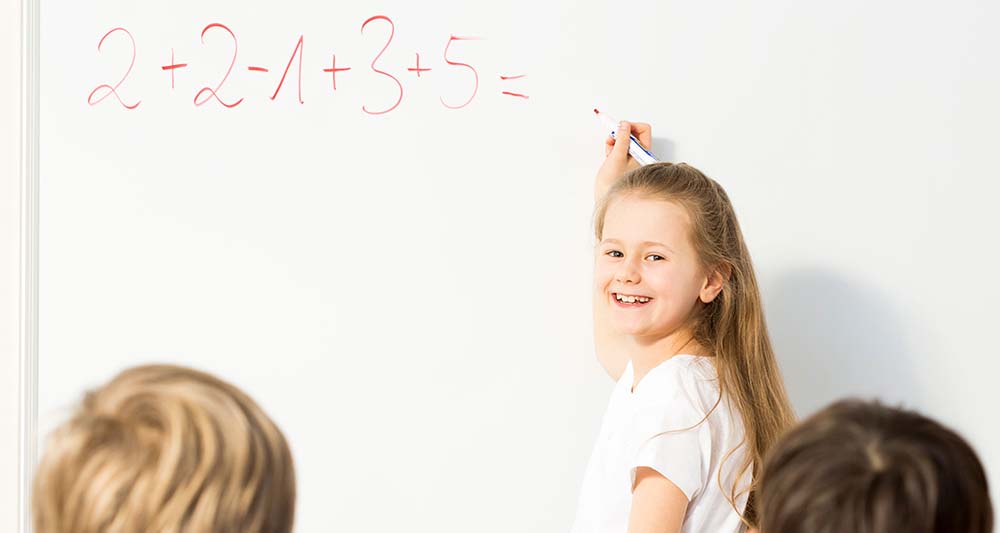Age-Appropriate Milestones for Math Learners
What is Age-appropriate Learning?
The child starts observing things around him and gathers interest in learning about the environment, as soon as his sight is developed, between 5-8 months. This means learning starts even before the kid enters a daycare center or preschool. As the child progresses with age, the brain starts preparing neural pathways which allows him to remember and grasp the concepts taught in school.
Though the child may be brilliant enough to absorb large amounts of information at toddler age, it doesn’t mean he should be able to memorize the World Map by age 3 or know the multiplication of 2-digit numbers like a professional.
Age-appropriate learning, which is practiced across most schools in Dubai, is a method that encourages children to grasp knowledge, as-per their level of readiness. The idea is to make the child feel comfortable enough and not get too stressed about their studies. After all, all knowledge and no play time makes Arham a dull boy!
Age-Appropriate Math Learning
‘I Love Math’, never did a child say that at the first go! A liking for the development of Math Skills is a step-by-step progressive agenda. It is the prerogative of teachers in GCC schools and parents, to inculcate a liking for the subject by adopting various easy-to-relate strategies, to make Math a joyous subject. So, let’s look at the stages at which a Math learner should acquire skills, and how involvement must be fostered, to make it an enjoyable process.

Development of Math Skills At Different Age Groups
At 0.8 – 3 years of age
This is the pre-match phase, where children get introduced to numbers and math concepts like shapes, without actually progressing toward their functionality. It is literally the foundation of the Math program and thus, the basics have to be very strong. If the educator sets the right tone, it enhances the child’s analytical skills and facilitates growth opportunities.
- Learning to count numbers from 0 to 9
- Arranging objects from big to small and small to big order
- Understanding different shapes such as; round, square, rectangle, & triangle and associating objects with different shapes
- Introducing opposites like; long – short, in – out, large – tiny, etc.
- Making use of words such as more, less, greater, and minor; while conversing & using day-to-day vocabulary
- Playing games where the child fills a glass container with water and observes the difference in level and volume
Use attractive materials and teaching aids such as; child-friendly plastic coins for counting, beads for counting & sorting, wooden manipulatives for learning shapes, and stacking wooden blocks as per the size, so that they can understand the concept of big & small. The above-mentioned material can be ordered on Amazon or purchased from a well-known local educational toy shop in the UAE.

At 3 – 5 years of age
By the age of 3, the child loves to experiment and develops curiosity. Students begin to get amused by gaining knowledge and get excited if you show them visually stimulating content that inspires hands-on learning. Some ideas to try with your Math learner in this age group include;
- Knowing how to count until 40
- Learning how to write number names till 20
- Going beyond simple shapes and being able to recognize; pentagons, rhombi, trapezia, hexagons, etc.
- Sorting objects as per different permutations & combinations (shape & color, quantity & size, odd & even numbers, etc.)
- Explaining what money is to children and its importance
- Matching the number of pom-poms with the corresponding digits
- Backward counting numbers from 10 to 1
- Comprehending the meaning of ascending order and descending order
- Solving puzzles and recognizing patterns to fit pieces together, to make a big picture
- Knowing what greater than, less than, and equals to is and correctly placing the appropriate sign, as it should be
- Taking the first step towards observing the different marks on the ruler and identifying what inch and cm, indicates
- Able to correctly write the date in dd/mm/yy format and read the calendar
- Starting to note the time and recognize the difference between seconds, minutes, and hours
By the age of 3+, children have a taste of digital teaching aids and therefore prefer learning on their tabs and mobile devices. To support Math learning and make it gamified, Mathseeds presents an excellent App-based platform for children of ages 3 and above. Mathseeds is quite popular all over the Middle East and they also offer a 30-day trial to start with. Their mascot Eggy is loved by all and challenges children to advance in Math via colorful animations, catchy music, and exciting rewards. So let’s motivate our children to be Math Experts, by following a patterned approach to teaching & make every small milestone count.






Recent Comments